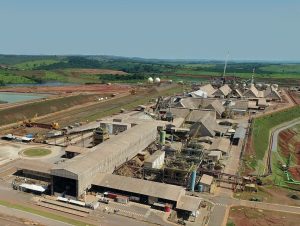
The future of food
Alzbeta Klein, CEO and Director General of the International Fertilizer Association (IFA), sets the scene for IFA’s Annual Conference in Monaco, 12-14 May.

Alzbeta Klein, CEO and Director General of the International Fertilizer Association (IFA), sets the scene for IFA’s Annual Conference in Monaco, 12-14 May.

PuraLoop is a new fertilizer created from recycled phosphorus. ICL’s Patricia Imas and Lucas van der Saag highlight its main benefits.

We compare and contrast the 2024 financial performance of selected major fertilizer producers following the publication of fourth quarter results.

CRU’s Humphrey Knight visits EuroChem’s newly opened Serra do Salitre phosphate fertilizer complex in southern Brazil.

Trammo, Inc. and ExxonMobil signed a heads of agreement to advance discussions for Trammo’s long-term offtake of 300-500,000 t/a of low-carbon ammonia from ExxonMobil’s Baytown, Texas facility. The facility is expected to produce virtually carbon-free ‘blue’ hydrogen with approximately 98% of CO2 removed, and will use this low-carbon hydrogen to make low-carbon ammonia. Trammo, a leading international physical commodity trader, will leverage its market and logistical expertise to deliver and sell in Europe and worldwide this unique low-carbon ammonia for use as fertilizer feedstock and for other key industrial applications.

In its 4Q 2024 results presentation, Abu Dhabi-based Fertiglobe said that it expects to reach a final investment decision (FID) on two clean hydrogen and ammonia projects in the US and Egypt in 2025. Fertiglobe confirmed that FID on the ADNOC-ExxonMobil low-carbon hydrogen and ammonia project in Baytown, Texas, is expected in 2025, with operations anticipated to begin in 2029. ADNOC’s 35% equity stake in the project will be transferred to Fertiglobe at cost once the project is operational.

The Saipem Clough Joint Venture says that it has reached a major milestone on Perdaman’s Project Ceres urea plant, with the completion of construction of the first modules. The batch has been successfully loaded out and shipped from the project’s modular fabrication facility in India to its destination in Western Australia. Once completed, the 2.3 million t/a facility will be the largest urea plant in Australia. Clough and Saipem in a 50-50 joint venture, are delivering the engineering, procurement of equipment and materials, construction, pre-commissioning and commissioning for the urea project.

New carbon capture-based plants could see US nitrogen capacity jump over the next few years, but Trump attacks on IRA tax credits may scupper some ongoing projects.

India’s push to replace its sizeable urea imports with home grown capacity continues, but may not keep pace with rising domestic demand.

Horisont Energi says that Fertiberia’s participation in the Barents Blue ammonia project will end on February 28th 2025. The two companies had been collaborating on the project since August 2023. Horisont Energi says that it is now looking for additional industrial partners to “further strengthen” the project, which aims to produce 1.0 million t/a of low carbon ammonia using 99% carbon capture at a plant at Markoppnes in northern Norway. Barents Blue has secured sufficient power supply for the first phase of the project, and is supported by a grant via the EU IPCEI hydrogen program, Hy2Use. The project is targeting a final investment decision in 2026 and estimated production start in 2029/2030.